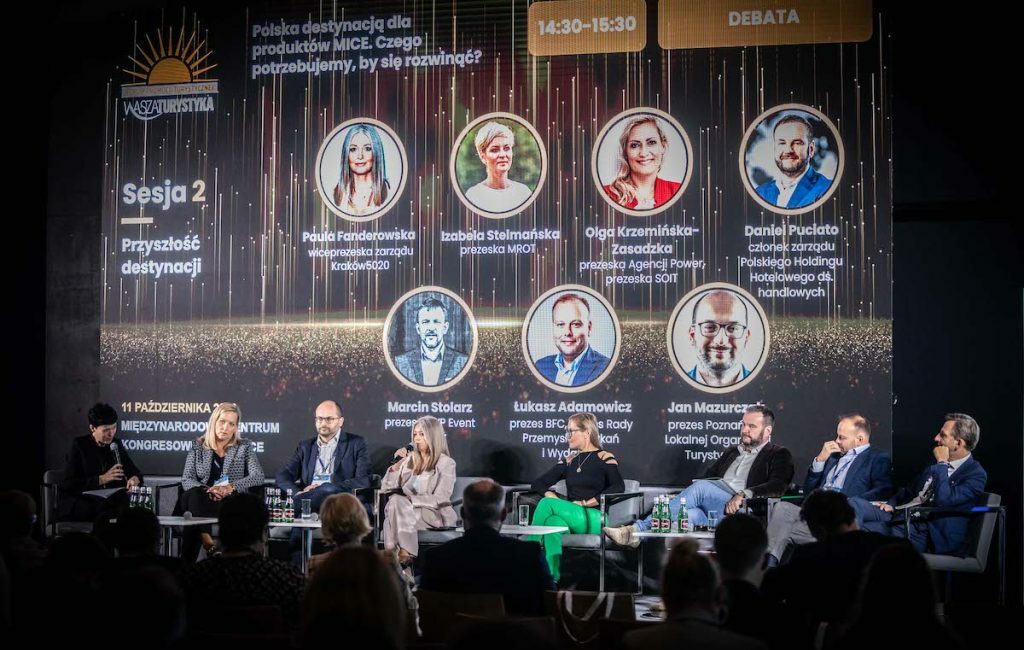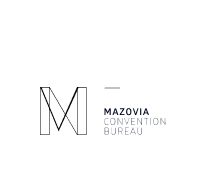One of the most important events in the tourism industry, the 13th Tourism Promotion Forum, is now behind us. The meeting at the International Congress Center in Katowice brought together over 230 representatives of the tourism sector, who had the opportunity to participate in substantive debates and discussions on the latest trends, innovations, and the future of tourism. Among the panelists was Izabela Stelmańska, President of the Board of the Mazovia Regional Tourist Organization.

How can Poland become an attractive destination for MICE events? This issue was the main topic of discussion, and our experts provided answers to this question. The speakers included Izabela Stelmańska, President of MROT, Paula Fanderowska, Vice-President of the Management Board of Kraków5020, Olga Krzemińska-Zasadzka, President of the Power Agency and President of SOIT, Daniel Puciato, Member of the Management Board of the Polish Hotel Holding for Trade, Marcin Stolarz, President of PTWP Event Center, Łukasz Adamowicz, President of BFC, and Jan Mazurczak, President of the Council for the Meetings and Events Industry. , Marcin Stolarz, President of PTWP Event Center, Łukasz Adamowicz, President of BFC and President of the Council for the Meetings and Events Industry, and Jan Mazurczak, President of the Poznań Local Tourist Organization.
“First and foremost, what we need is strategic thinking about the MICE sector as a key part of the country’s economy. We need to have something that will set us apart, and by that I mean local character and hospitality. I am convinced that Poland, as a leader in business tourism, can confidently strive to be a pioneer. Organizing international meetings of the highest importance puts us in the role of a trendsetter. I believe that we should strive to be a brand that creates trends, not just follows them,” says Paula Fanderowska, Vice President of the Board of Kraków5020.
“What we need most of all is trained staff. We don’t have the funds to train new staff, which means we are unable to attract them to tourism. For me, this is the foundation for moving forward and developing,” adds Olga Krzemińska-Zasadzka, president of the Power Agency and president of SOIT.
“Tourism after the pandemic is no longer as attractive an employer as it used to be. Indeed, staff is currently a very big problem. Let’s remember that the MICE sector is good for the entire tourism industry. We work outside the high season and bring in customers who have budgets up to three times higher. It is easier for us to attract foreign tourists because we have a specific reason, such as trade fairs or various types of congresses,” says Łukasz Adamowicz, president of BFC.
“If we are talking about Poland as a leader in the MICE industry, first and foremost we must believe in our own strengths. What is encouraging is that we are already competing confidently with various players, without any complexes. Another key element is cooperation and showing what we have to offer. Promotion also plays a key role, but I agree with the previous speakers that locality and the use of our unique assets should be emphasized. Each region of Poland has its own specific character, and Poland as a whole has a lot to offer. This is what should attract the attention of organizers. By showing what makes us different, we can convince them that Poland is a great destination for their events,” commented Izabela Stelmańska, president of MROT.
“When it comes to investments related to the development of tourism, it is worth emphasizing that each destination, whether it is Lublin, Warsaw, Poznań or Gdańsk, has its own unique characteristics and challenges. Each place has certain shortcomings or needs that should be identified and addressed, especially when it comes to hosting large events such as international congresses. In addition to infrastructure and logistics, cultural and recreational offerings are of great importance. For guests, especially those from abroad, evenings and free time must be full of attractions. The attractiveness of a given place and its surroundings is a key factor in attracting tourists. When considering large-scale investments, such as infrastructure, it is worth paying attention to the return on investment. MICE events attract customers with larger budgets, which means greater financial opportunities for local businesses. The example of Katowice shows that investments in the development of business tourism can bring enormous benefits, both for the city and for the region. It is worth appreciating that this form of tourism generates significant income and contributes to the development of the local economy,” comments Marcin Stolarz, president of PTWP Event Center.
“If we focus on the MICE sector, there are certain key aspects that we need to pay attention to in order to meet customer expectations. First, location plays a key role. It is important that the venue is close to both conference rooms and tourist attractions. In addition, transport links are important, so the venue should be easily accessible. Secondly, security is a key aspect. Business customers pay attention to security in both geopolitical and local terms. Thirdly, conference rooms must be flexible, both in terms of quantity and layout. The equipment in these spaces is also important. Fourthly, staff play a huge role. Not only are they required to be fluent in English, but they also need to have a friendly and helpful approach to organizing this type of event. Finally, price is becoming an increasingly important factor. Bidders often ask about various commercial terms, such as the possibility of free cancellation or payment terms,” said Daniel Puciato, member of the management board of Polski Holding Hotelowy responsible for commercial matters.
“The development of the MICE market in Poland is a key issue, but new challenges are emerging. We are proud of the level of development we have achieved and we compete effectively with the world’s largest cities in organizing global congresses. Nevertheless, the expectations of congress organisers are constantly changing. One of the problems is price competitiveness. Poland is no longer the cheapest destination, which makes it difficult to attract large congresses. A year ago, there were even considerations to adopt the financial incentive model known from the film industry, where producers can recover part of their costs after completing projects in the country. In Poland, we also have the opportunity to attract new members to international associations by organizing congresses, which can bring long-term benefits,” said Jan Mazurczak, president of the Poznań Local Tourist Organization.
Source: www.WaszaTurystyka.pl / Photo: Jakub Krawczyk | Lighthouse Media


